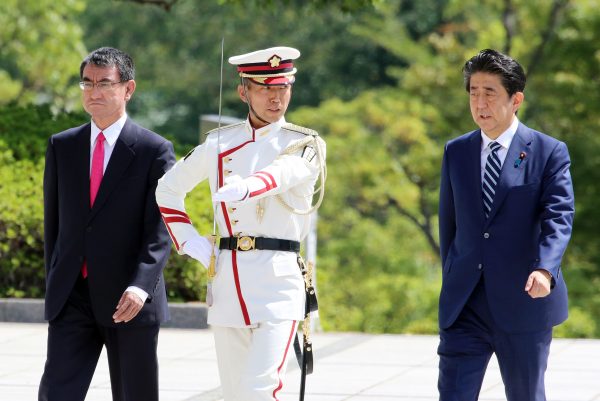The use of the space domain for national defence is not new for Japan, having utilised satellites for information-gathering, communication and navigation in the past. But the increasing dependence on space also means greater vulnerabilities to space debris as well as threats from adversarial weapons systems that can attack or disrupt systems via kinetic and electromagnetic means. Facing the growing uncertainties that come along with space, Japan has begun to take bolder steps to better understand the domain.
Japan’s long-term commitments to space security are reflected in the defence budget. The provisional defence budget for the 2020–21 fiscal year devotes 50.6 billion yen (US$460 million) to space-related programs. This figure is unsurprising when looking at the budgetary commitments of the Ministry of Defense since 2011.
Still, the contents of the outlays have changed in recent years. Until 2015, costs were largely associated with research on the broader space domain and the use of satellites. But since 2016, space-related expenditures have increasingly focussed on establishing capabilities such as Space Situational Awareness (SSA) to detect, track and identify objects in space, as well as units such as the SDMU.
To develop capabilities for space security, Japan first needed to set the strategic, institutional and policy foundations. Japan established two key organs within the Cabinet Office: the Office of National Space Policy — later reorganised as the National Space Policy Secretariat — in July 2012 and the Strategic Headquarters for Space Development in 2015.
The Abe government has also issued the Basic Plan on Space Policy along with various laws such as the Space Activities Act concerning the conduct in, as well as safety and security of the space domain.
Development in capabilities focuses on three areas. First is the establishment of an SSA system. Second is improving space-based capabilities including intelligence, surveillance and reconnaissance, communication and positioning. Third is superiority in space, including the capabilities to electromagnetically disrupt an adversary’s command, control, communications, computers and intelligence (C4I) systems. The Ministry of Defense has for the first time launched its own X-band communications satellites — kirameki-2 in 2017 and kirameki-1 in 2018 — to enhance the command and control of Japan Self-Defense Force (SDF) units.
But while Japan’s developments are certainly significant, the country is not yet able to deal with the threats in space, particularly those posed by China and Russia. Japan’s alliance with the United States is vital as an enabler given the nascent nature of Japan’s space defence capabilities. In 2015, Japan and the United States signed the updated Guidelines for Japan–US Defense Cooperation which pledged to expand the partnership to cyber and space domains. The establishment of the SDMU in the SDF serves as a formal counterpart to the recently established US Space Force.
For now, the SDMU will be modest in size with 20 personnel who will work on developing preliminary capabilities before the full launch of the unit in 2022. There are a number of challenges going forward despite the developments made by the Ministry of Defense.
First, questions remain over the kinds of strategies and operations allowed or disallowed under the current constitutional framework. While there will be little fuss over SSA systems, communications systems and navigational assets, defensive measures such as disrupting the C4I systems of adversaries are likely to raise controversy.
Second, there will also be tough questions over how the SDF will balance the development of capabilities for space security with other priorities such as air and naval supremacy, ballistic missile defence, amphibious operations and electromagnetic and cyber warfare. As long as Japan’s defence budget remains at 1 per cent of GDP, Tokyo will face dilemmas in setting priorities.
Japan is unlikely to marginalise capabilities for security in the domain of space, given its importance. But comprehensively enhancing the SDF’s readiness in the space domain will be far from easy considering the high investment costs associated with the required capabilities.
Developing the SDF’s space capabilities depends considerably on cooperation and coordination, not only with the United States and likeminded states, but also other government agencies — particularly the Japan Aerospace Exploration Agency — as well as the private sector. While the Ministry of Defense has vowed to work closely with such organs, the partnerships are still young and it will take time before they can generate substantial collaboration.
Space security is now a vital part of the SDF’s operations. Although Japan is relatively advanced and experienced in space-related science and technology, it will take time before this knowledge can be converted into real, robust defence capabilities in this new domain.
Ryo Hinata-Yamaguchi is Visiting Professor at the Pusan National University and an Adjunct Fellow at the Pacific Forum.

